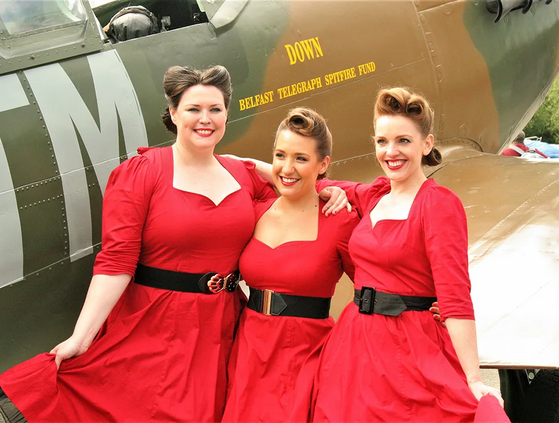> COLLECTION > AIRCRAFT > SECOND WORLD WAR > Spitfire Replica
SPITFIRE Replica

Image: PAUL YOUNG

Image: PAUL YOUNG
UAS acquire “Down” Spitfire Mk2a Replica
It was like Christmas Eve, but four days early: A Santa Claus sleigh in the form of a bright red trailer behind a ponderous truck, twisting gingerly off the dark driveway into our flood-lit hangar compound. Perched upon it was only one, large present: a Spitfire.
That’s how it was, that night of Dec 21st, 2013, complete with a gaggle of grinning UAS members on the tarmac, watching in childlike glee as the gift-laden lorry eased to a halt. And who really cared that the star of the stage at that moment was just a replica Spitfire? We’d bought her and she was ours!
The night wind battered the fighter’s trembling wings, begging them to act natural and fly away, free of the straps that secured them to the flimsy cradle atop the trailer. Instead, a dozen pairs of eager hands sprang out of the shadows.
They loosened the ratchets, held her here, teased her there, and led her respectfully, part by part, over the threshold of her new hangar home. In the few years we’ve had her, she’s treated us very well indeed.
Thousands of visitors have clambered aboard for a cockpit photo or just stood in awe, gazing at the carefully-crafted, full-sized symbol of a legend. She’s a Spitfire Mk IIa, with a new identity we’ve given her: P7823 of 504 Squadron (code TM.F), in the Royal Air Force.
History of the Spitfire Mk2a Replica "Down"
The original P7823 was based with the Squadron at Ballyhalbert in the autumn of 1941. It was one of 17 Spitfires purchased through the Belfast Telegraph Spitfire Fund, set up through donations of thousands of individuals as well as businesses and private organisations.
Each aircraft bore the name of a community, county or region in Northern Ireland. Spitfire P7823 was named after County Down, and was the only aircraft from that fund which was based in Northern Ireland. It was flown by a number of pilots in the squadron, among them Cecil Austin, father of BBC presenter Wendy Austin.
The last pilot of P7823 was a Canadian from Ontario, Walter McManus. He was killed when the aircraft crashed and burned in January, 1942 north of Lurgan. His remains rest in a small churchyard at Ballycranbeg, near Ballyhalbert. The cause of the crash was never determined.

Spitfires had a short but interesting association with Northern Ireland. The first one appeared here in July, 1939, at an air show at Belfast Harbour Airport.
But it wasn’t until the arrival of 504 Squadron at Ballyhalbert in 1941 that Spitfires arrived here in any numbers. In fact, 504 Sqn was the only Spitfire unit to be based here which could claim to have been involved in bringing down an enemy aircraft.
The aircraft in question was a Junkers Ju88, shot down on 23 Aug., 1942 when attacked by a succession of Spitfires while attempting to return to its base in France from a Luftwaffe reconnaissance mission over Belfast.
Other Spitfire units were based here — often quite briefly — during the Second World War. Among them was 133 Sqn, with an American pilot who achieved a unique slice of fame after his Spitfire crashed in a Donegal bog in 1941.
The south was neutral during the war and young Roland ‘Bud’ Wolfe was interned there, but after two escapes he eventually ended back with 133 Squadron.
The remains of his aircraft were retrieved from Inishowen in 2011 following search and research by Jonny McNee, who has exhibited bits and pieces of that Spitfire from time to time in conjunction with our Society.
Among the other RAF squadrons assigned to Northern Ireland for varying periods of time were numbers 41, 74, 130, 134, 152, 485 and 501. Three squadrons of the U.S. Army Air Force’s 52nd Fighter Group also put in a brief appearance at Eglinton and Maydown.
Two Polish squadrons of the RAF, numbers 315 and 303, flew out of Ballyhalbert between early July, 1943 and late April, 1944. Their reputation for fearless action against enemy aircraft was well known, and they found the lack of hostile activity somewhat frustrating, but were off to more demanding assignments elsewhere by the summer of 1944.
Several Spitfire and Seafire units of the Fleet Air Arm were based in Northern Ireland from time to time, though usually for periods of short duration.
Met Flights for NI Spitfires after War
Spitfires weren’t always used in an aggressive role during the war.
Meteorological flights flew out of Aldergrove during the later years of the conflict. After the war, those flights continued to the end of 1948, and 502 (Ulster) Sqn of the Royal Auxiliary Air Force flew fighter versions from 1948 to 1951.








